Part III. Italy
Chapter 46. San Gimignano [March 12, 1348]
Cultural Explanations
 |
Part III. Italy Chapter 46. San Gimignano [March 12, 1348] Cultural Explanations |
|
 |
In this chapter Bávlos finds a second Fina. |
| San Gimignano, St. Fina |
In this chapter, Bávlos visits the village of San Gimignano on the feast of St. Fina. By observing the paintings in the principal church of the community, he begins to understand more of Iesh's life and trials. He also takes acts to secure his reindeer from theft, apparently receiving supernatural assistance either from his grandfather's spirit helpers or from St. Fina. In either case, the apprehension of the would-be thief is regarded as a miracle among all who hear of it.
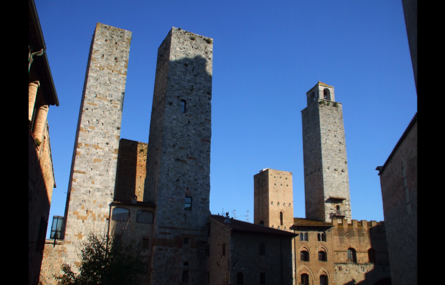 |
| San Gimignano |
In contrast to many Tuscan cities, San Gimignano retains much of its medieval architecture and ambience. High towers ("medieval skycrapers") were a means of defending one's home and goods from theft, and merchants often vied with each other for who would have the highest tower in town. During later centuries, the Medici duke of Florence forced families to reduce their towers' heights in many subject cities, a potent means of asserting the Grand Duke's superiority over all other members of society. For whatever reason, such reductions did not occur in San Gimignano, making it a unique relic of medieval Italian city architecture. Many towers have disappeared over the course of the centuries due to decay or rebuilding, but enough remain to convey the once dense and vertical nature of this small walled city on a hill. One of the surviving towers was owned by the Vespucci family, who would later relocate to Florence. Amerigo Vespucci (1454-1512) would later rise to fame as an explorer and cartographer; it is widely believed that the term America is derived from his name.
The paintings which Bávlos views are located in the Collegiata, San Gimignano's equivalent of a cathedral. When San Gimignano lost its independence to Florence in the aftermath of the Plague year of 1348, it also lost its right to have its own bishop. Thus, its grand central church could no longer be called a cathedral, since no bishop had his seat there. In every other respect, however, the collegiate church of San Gimignano is as magnificent as many a cathedral in other communities, and the paintings that grace its walls are among the most striking in medieval Italian iconography. Scholars are not sure who created the series of frescos that Bávlos views, but they are now dated to the early fourteenth century and attributed to the school of Simone Martini (1284-1344), one of the key early figures in the development of the style known as the "International Gothic." Below are some of the images from this striking fresco series.
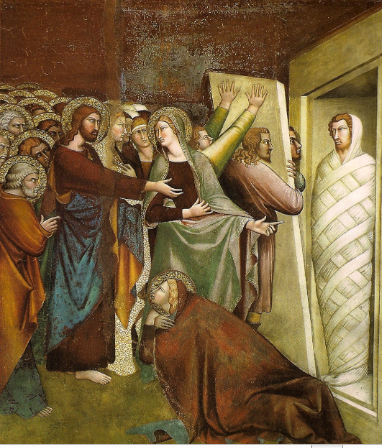 |
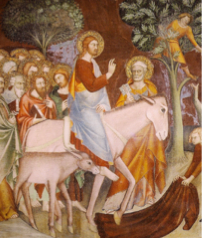 |
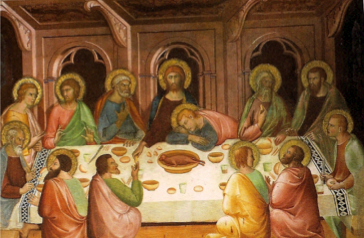 |
| The calling forth of Lazarus | The arrival in Jerusalem | The Last Supper; note otter-like dinner item |
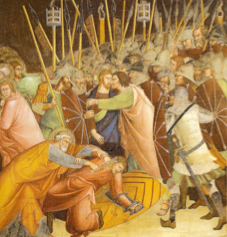 |
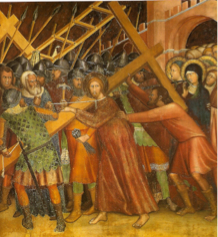 |
| The confrontation in the garden | The carrying of the Cross |
St. Fina (1238-53) remains popular in San Gimignano even today. In 1348, her cult was only a century old, and pilgrims were still flocking to her relics in hopes of a miraculous cure. A large hospital and inn had been erected, and devotion to the humble female saint had largely displaced teh town's earlier devotion to St. Geminianus, bishop of Modena (d.397). St. Fina belongs to a class of female saints known for their serenity during chronic pain or suffering. Unlike the earlier female martyrs, who are depicted boldly enduring acute torture for the faith and dying violent deaths at the hands of sadistic emperors, St. Fina becomes an exemplar of patient suffering and endurance over the course of years, with her body literally rotting out from within. Out of her placid suffering rises the ability to cure other people, during her years of invalidism and certainly after her death. Medieval theology suggested that saints could prove particularly helpful in answering prayers while their cults were still new, growing potentially less efficacious over time. God, theologians argued, allowed for miracles in connection with new saints so as to build up their cults: once established, the need to answer every prayer was not as great. Thus, the medieval faithful were always on the lookout for a new saint and eager to monitor the occurrence of miracles in connection with holy relics in the vicinity. Often, the recorded miracles are closely connected to the ordinary life of peasants or merchants, as with the one depicted here: the prevention of an act of theft.
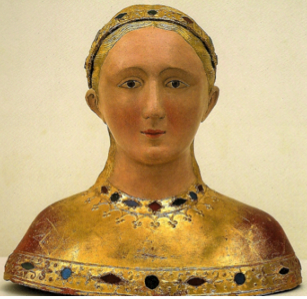 |
| Reliquary of St. Fina, fourteenth century |
St. Fina's fourteenth-century head reliquary depicts a blonde-haired maiden, very reminiscent of Katarina of Sweden. Such reliquaries, representing the head and shoulders of the saint, typically housed the saint's actual skull or some smaller fragment of head bones. The faithful prayed before the reliquary as a means of entreating the saint for assistance. On the saint's feastday, it was common to parade the reliquary through the city as a means of invoking the saint's blessing on the wider community and reminding the populace of the spiritual resource stored at the church. Blonde hair, though relatively rare in Italy, was nonetheless regarded as beautiful in the medieval period, and saintly and aristocratic women were often depicted as blondes. There is evidence that already in the Roman era, Italian women were dying their hair, evidence of milennia of chemical waste.
While Bávlos is learning more about Christianity, the chapter depicts him also retaining a variety of Sámi views and ideas. The account of a noaidi using supernatural powers to prevent the theft of reindeer is drawn from Sámi oral tradition as recorded by J. Qvigstad. In the chapter, Bávlos fuses this indigenous tale with the Christian concept of intercession. Bávlos also interprets the two Finas he has met—the Swedish Fina (actually St. Katarina, St. Birgitta's faithful daughter and the eventual founder of the Birgittine order) and the Italian St. Fina of San Gimignano—as a parallel to the Sámi concept of twin sieiddit. A sieidi stone could exist on the shore but be linked with a twin stone said to lie in the middle of a river or lake. Offerings made to the shore sieidi would be shared with the otherwise inaccessible twin, who would exercise its control over nearby fish for the benefit of the petitioner. Bávlos further tries to understand Iesh—Christ—in Sámi terms, believing him to actually be a Sámi who ended up in the Middle East. This is an idea Bávlos has picked up while hearing of Pekka's theories of the Finnish nature of Iesh. Note that Bávlos thinks of the various saints and biblical figures with their names in the languages in which he first learned about them. Thus, Sts. Peter and Joseph are called by their Finnish names—Pekka and Jooseppi—while St. John the Baptist is called San Giovanni.